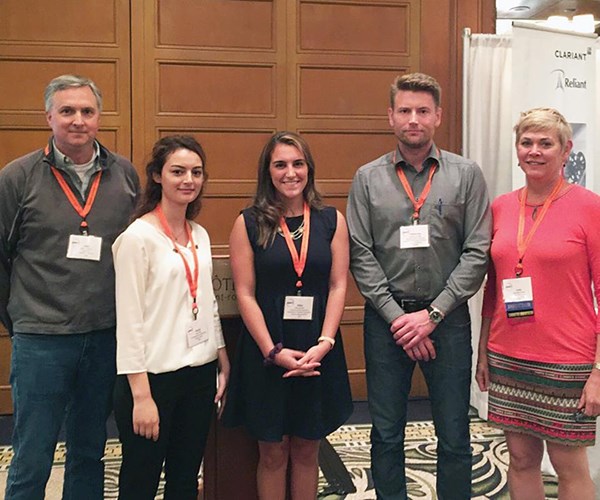AAC Announces 2016 Winners for Student Research Poster Contest
Students from around the world presented research projects in science, bioengineering, nanotechnology, petrochemical technology, corrosion science, and related engineering disciplines presented their work.

(From left to right) AAC Academic Outreach Chair, John Thornton; Burcin Bilici from Istanbul Technical University; Abby Koczera from the University of New Hampshire; Flemming Jensen from Technical University of Denmark; and AAC Education Chair, Dr. Jude M. Runge.
The Aluminum Anodizers Council (AAC) held its third Student Poster Session at the 25th Annual Anodizing Conference and Exposition this fall in Montreal, Canada. Students from around the world presented research projects in materials science, bioengineering, nanotechnology, electrochemical technology, corrosion science, and related engineering disciplines presented their work.
The posters were presented to the three judges including AAC Education Chair, Jude M. Runge, Ph.D. of CompCote International; AAC Academic Outreach Committee Chair John Thornton of Apple, Inc.; and Mark Jozefowicz, AAC Education Committee Member of Reliant Aluminum Products. Three posters were chosen as equal winners and were each awarded a $500 scholarship.
Burcin Bilici of Istanbul Technical University in Istanbul, Turkey was commende for her poster, Investigating the Effect of DC Pretreatment on the Corrosion Behavior of Black Colored Anodized Aluminum Film. The focus of the research used AAO to study and control neuronal growth from stem cell precursors, according to the abstract.
Abby Koczera from the University of New Hampshire was awarded for her poster, The Effects of Carboxylic Acid Additives in Anodic Alumina Coatings on Corrosion Resistance. Koczera’s research focused on stress corrosion cracking (SCC) and hydrogen-induced cracking (HIC) in aluminum alloys. According to the abstract, “the purpose of [the] study is to determine if the scanning vibrating/reference electrode technique (SVET/SRET/SVP) can be used to monitor the coupling current flowing through the solution.”
Flemming Jensen from the Technical University of Denmark in Lyngby, Denmark was awarded for his poster, In-situ Temperature Measurement during High Frequency Pulse Anodising of Aluminium. The poster addressed the search for an environmentally friendly anodizing process for magnesium alloys. “Nitric acid etching was extensively studied, influence of various operating parameters being clarified through a kinetic and thermodynamic study. Our study allowed predicting the etching rate and to clarify the different reactions occurring during pickling. Then an innovative anodizing process, performed in [an] acidic and environment-friendly medium, is studied,” the student noted in the abstract.
AAC will soon issue the Call for Student Posters for the 2017 Anodizing Conference and Exposition. The 26th Anodizing Conference and Exposition is scheduled for September 19-21, 2017 at the Westin Westminster in Westminster, (Denver) Colorado. For event information, visit the AAC conference website at AACconf.org.
For more information, visit anodizing.org.
Related Content
-
California Public Hearing to Decide Fate of Hex Chrome Plating and Anodizing
Metal Finishing Association of California urges all members of the metal finishing community to submit comments prior to the hearing.
-
A Smooth Transition from One Anodizing Process to Another
Knowing when to switch from chromic acid anodizing to thin film sulfuric acid anodizing is important. Learn about why the change should be considered and the challenges in doing so.
-
Trivalent Chrome Overview
As the finishing industry begins to move away from the use of hexavalent chromium to trivalent chromium, what factors should finishers consider as they make new investments? Mark Schario, chief technology officer for Columbia Chemical offers a helpful overview of this complicated topic.














